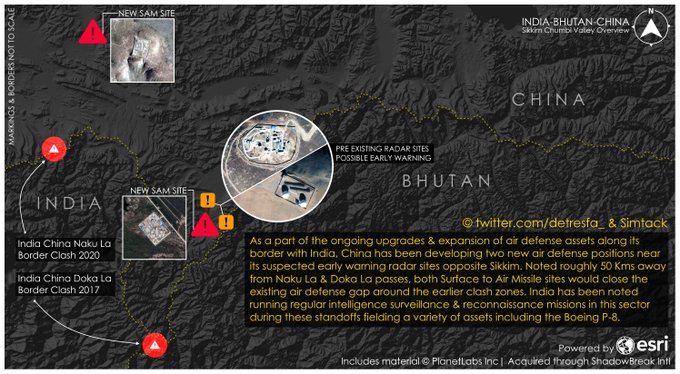SOURCE: THE PRINT

China has been developing two air defence positions that will cover the 2017 Doklam stand-off area and also Naku La in Sikkim, which witnessed a clash between Indian and Chinese soldiers this year, new satellite imagery suggested Friday. The Chinese efforts to build air defence positions on the eastern section of the Line of Actual Control (LAC) come even as tensions with India continue in the western sector in Ladakh.
Information about the Chinese air defence positions came to light as a prominent Twitter handle that regularly posts satellite imagery — @Detresfa_ — made a fresh post Friday.
Putting out the images as part of a joint study with Sim Tack of the geopolitical intelligence platform Stratfor, @Detresfa_ said the location is near the China, Bhutan and India tri-junction at Doklam, where New Delhi and Beijing were locked in an-over-two-month stand-off in 2017.
The People’s Liberation Army (PLA) air defence infrastructure, the user added, is being constructed roughly 50 km from the 2017 stand-off site, and the location of the May 2020 scuffles.
The user said the positions, identified by @Detresfa_ and Tack as “surface-to-air missile sites”, will close the existing air defence gaps around the clash zones.
It is pertinent to note that India has been regularly flying surveillance missions in this area to keep an eye on Chinese activities, both in Doklam and in the Northeast.
‘Pressure tactic’
Even though India and China had disengaged in Doklam in 2017 after a 73-day stand-off, the PLA continues to dominate the areas it had crossed into.
China has been pressuring Bhutan to strike a deal on the Doklam boundary dispute, under which Beijing wants the Chinese holding line in the contentious region to become the working boundary between the two.
The Chinese have also continued with their construction activities on their side of the LAC in the western sector as well even though there has been no forward movement in disengagement talks since July. According to sources in the security and defence establishment, the construction is meant to provide back-up for the thousands of troops China has moved forward near Ladakh, and also into the Indian side, and may also be a possible pressure tactic.
China’s withdrawal in July from near the Y Junction in the Galwan Valley, which is on the Indian side, is seen more as a fallout of the Galwan river’s rising water level, which made their stay untenable, rather than any sincere effort to disengage, sources had told ThePrint earlier.
from Indian Defence Research Wing https://ift.tt/2Qy57bg
via IFTTThttp://idrw.org
No comments:
Post a Comment